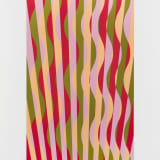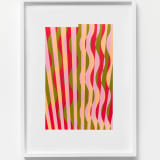

Michael Kidner Red China, 1966
34 x 24 in
Red China (1966) is an example of Kidner’s exploration of continuous waves, supported by his striped paintings constructed from two alternating colours. This period was significant as it symbolised Kidner's turn towards creating rational art while the physicality of a wave interested Kidner as a pattern, generating more visual prospects than a straight line. With the wave's potential to be woven within and out of phrases, resulting in optical effects separating colour and form, there is an allusion to both the conception and culmination of a sequence, with the work implying the wave's rhythm is at once limited and infinite.
The title and the date reference the political state of China, as 1966 marked the inception of the Cultural Revolution by the founder of the People’s Republic of China, Mao Zedong, resulting in a decade-long period of social and political unrest. Kidner’s use of red both in the title and the painting signifies the domination felt throughout China and the violence caused by the political purification.

